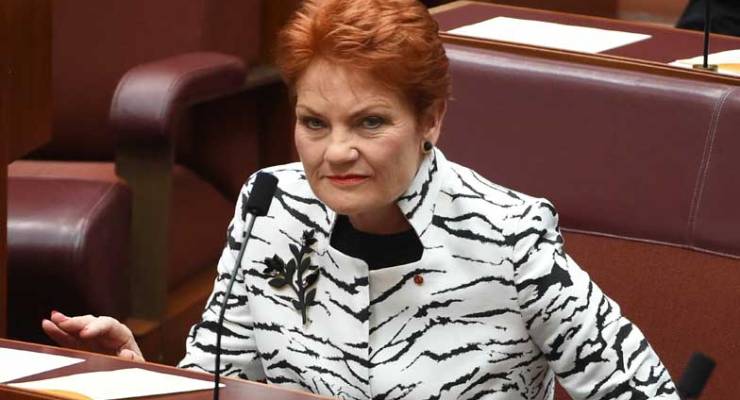
The brave new world of Senate electoral reform becomes a reality today, with the swearing-in of the 76 candidates elected at the double dissolution election on July 2.
Perhaps even more significantly, a new age of populist right-wing politics is to be ushered in following the electoral triumph of Pauline Hanson’s One Nation, whose four seats constitute a formidable bloc of the 11 votes on what now gets described as the crossbench.
This aspect of the outcome has been the main focus of those claiming vindication for their opposition to the reforms — particularly in the Labor camp, where Hanson’s return offers a rare opportunity to skewer the Greens from the left.
However, the Hanson revival is largely a target of convenience for enthusiasts of the old system, whose arguments when the bill was being debated in March were of a rather different strain.
As the Prime Minister pushed the issue on to the agenda in mid-February, a report in the Fairfax papers cited “two experts on the preference system” — Peter Breen and Graham Askey, both of whom were candidates of the Renewable Energy Party at the recent election, with Breen being a former micro-party member of the New South Wales state upper house — who predicted the Coalition “would seize a rare absolute majority in the Senate if it finalises a deal on voting reform and calls a double dissolution election”.
Labor Senator Sam Dastyari was only slightly more circumspect, claiming proposed reforms would entrench the Coalition and “risk forever preventing a progressive Senate”.
Dastyari also warned of a second looming menace: an “analysis” showing the rate of informal voting would spike to “almost 10%”, since the Australian Electoral Commission would “not have enough time or funding to educate the electorate”.
This was based on the experience of the last change to Senate voting when above-the-line voting was introduced at the 1984 election, which caused the informal vote in the House of Representatives to shoot up from 2.1% to 6.3%, as many wrongly concluded they could number a single box there as well.
[Derryn Hinch’s Senate diary: a Crikey exclusive]
A third danger was said to be the new phenomenon of exhausted votes, whereby votes in the new system drop out of the count beyond the point where voters cease numbering boxes, rather than being shepherded through to the end in the manner prescribed by their favoured party’s group voting ticket.
Outgoing Queensland Senator Glenn Lazarus complained it was “extremely antidemocratic” to dispense with a system in which “no vote is ever wasted”, while David Leyonhjelm of the Liberal Democratic Party and Bob Day of Family First argued that affected voters would be “disenfranchised”.
The spectre of Coalition domination invoked by Breen and Askey scarcely warrants a response, and Dastyari’s view that the reforms would in any way tilt the chamber’s left-right balance found little if any support from the election result.
Concerns about informality were borne out to the extent that the rate of informal voting in the Senate was up from 2.96% at the 2013 election to 3.94%, some of which may have resulted from below-the-line voters numbering fewer than the minimum of six boxes required for a formal vote (which was not a requirement for a formal above-the-line voting, regardless of what the ballot paper said).
However, in stark contrast to 1984, informal voting in the House of Representatives actually fell, from 5.9% to 5.0%, which may have been assisted by the demise of a Senate ballot paper directing voters to number a single box.
The notion that exhausted votes amount to a violation of democratic rights is a curious one, as it implies that the great many voters whose votes in the lower house end up with the losing candidate are “disenfranchised”.
It might carry some weight under the purer forms of proportional representation, such as in the Netherlands, where the nation at large votes for a chamber of 150 seats and only the very smallest parties are left without representation.
But in the context of the Australian Senate, where elections have never been for more than 12 seats, it doesn’t cut much ice — particularly considering that voters have it within their power to number every box, if it really means that much to them.
The principle of the Senate system, then and now, is that votes are sifted through the preference distribution until seven candidates are left standing (13 in the case of a double dissolution), six of whom are elected — and one of whom is not, resulting in the “wastage” of their portion of the vote.
To the extent that the new system can be regarded as wasting more votes than the old one, the measure of the difference is the extent to which some candidates were able to win by the grace of exhausted votes with less than a full 7.7% quota.
This didn’t happen at all in Western Australia and did so just barely in Queensland, where One Nation Senator-elect Malcolm Roberts’ famously low starting position of 77 below-the-line votes had blossomed to 206,165 at the final count, barely shy of a quota of 209,475.
[The worst result of election night: the return of Hanson]
The “worst” of the results from this perspective was the election of David Leyonhjelm to the last seat in New South Wales with 6.1% of the vote after preferences, 1.6% short of a quota — probably about as much of the vote as he owed to people confusing his Liberal Democrats with the Liberal Party.
If this indeed rates as an imperfection in the new system — a view that requires a rejection of the notion that a voter might legitimately choose to have their vote drop out of the count — it’s clearly a minor one, and far from the worst.
The only argument remaining to opponents of reform is that crossbench seats that would otherwise have been allocated to obscure micro-parties in an all but random fashion were instead won by One Nation.
And whatever else might be said about Hanson and her cohorts, those who put them where they are today did so with their eyes wide open.
*To read more from Crikey‘s William Bowe, visit The Poll Bludger








Excellent analysis Mr Bowe.
“a view that requires a rejection of the notion that a voter might legitimately choose to have their vote drop out of the count ”
A factor that I took into account and used gleefully. In fact, the old system was much more inscrutable as even though I numbered every box below the line I had no idea where my vote ended up, and could have theoretically been counted towards my last placed candidate. (yes, unlikely I know, but still, I had no idea where my vote ended up)
I must admit however that I did not agree with the proposed reform largely on the basis that the reasoning provided was not addressed by the system used, with the corollary that we still ended up with clods that were voted in on much less first preference votes than Ricky Muir. In other words, I didn’t buy the bullshite.
“my vote … could have theoretically been counted towards my last placed candidate”
No it couldn’t, only towards your second last placed preference, and then only if your last and second last were the two fighting out the last spot.
I’m not sure why giving away your last vestiges of choice filled you with “glee” – relief out of sheer exhaustion maybe, but “glee” at choices so abysmal that you allowed others to make the decisions for you? Personally, I want to have a say to the bitter end, even if it’s merely between whether I have my throat cut with a rusty blade or a blunt one.
Brekky – you have previously mentioned that you work with data sets and are therefore, presumably, numerate so I’m stunned by your claim of being mystified by where you vote ends up.
As for Billy Bowes, he has the political perspicacity of a boiled turnip and an astonishing blind spot which one would expect to be fatal to a psephologist.
Sorry William…I’d rather have Ricky Muir and Glen Lazarus any day!
So back to the original system for me!!
The AEC were clearly worried about the potential number of informal senate votes and, therefore, exercised their discretion and allowed a single vote above the line to count as formal. No one saw that coming – so Sam Dastrayi is not necessarily wrong in his prediction.
“The notion that exhausted votes amount to a violation of democratic rights is a curious one, as it implies that the great many voters whose votes in the lower house end up with the losing candidate are “disenfranchised”.”
I don’t think this is an implication of Day’s argument. In full preferential, the worst that can happen to a vote is that it goes to the last candidate eliminated, regardless of whether the electorate is multi-member or single-member. In optional preferential, it can be exhausted long before this. Nonetheless I agree that Day’s concern is not a major worry, and hardly merits the word “disenfranchisement”.
I was one of those worried about exhaustion rates and was pleasantly surprised. Provided they remain low, the system is an improvement, and I think will probably look even better once we’ve seen a full six-year, half-senate replacement cycle.
But no system is perfect, and each has its advantages. Under the old one, in Victoria, a quota’s worth of voters effectively said “anyone but the major parties” and got – Ricky Muir. This time, two quota’s worth of voters in Queensland effectively voted for Pauline Hanson and, yes, they got her – but also Malcolm “Punctuation” Roberts. Did they see him coming?
A third danger was said to be the new phenomenon of exhausted votes, whereby votes in the new system drop out of the count beyond the point where voters cease numbering boxes, rather than being shepherded through to the end in the manner prescribed by their favoured party’s group voting ticket.
Danger ? It’s the freakin’ POINT !